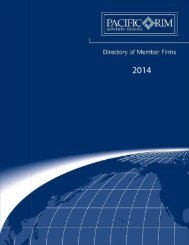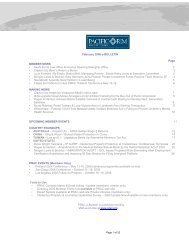A Guide to the Law of Securitisation in Australia - Clayton Utz
A Guide to the Law of Securitisation in Australia - Clayton Utz
A Guide to the Law of Securitisation in Australia - Clayton Utz
- No tags were found...
You also want an ePaper? Increase the reach of your titles
YUMPU automatically turns print PDFs into web optimized ePapers that Google loves.
enefit. The Commissioner can <strong>the</strong>n impose withhold<strong>in</strong>g taxcalculated on <strong>the</strong> tax benefit <strong>to</strong>ge<strong>the</strong>r with possible additionaltax <strong>of</strong> 25 percent or 50 percent depend<strong>in</strong>g upon whe<strong>the</strong>r <strong>the</strong>payer has a reasonably arguable case.A specific anti-avoidance provision deems amounts <strong>of</strong> <strong>in</strong>terestpaid by an <strong>Australia</strong>n resident through a tax-exempt <strong>in</strong>terposedentity <strong>to</strong> a non-resident recipient, <strong>to</strong> have been paid by <strong>the</strong>resident directly <strong>to</strong> a non-resident. Payments made <strong>in</strong> such amanner are <strong>the</strong>refore be subject <strong>to</strong> IWT.5.3.7 Commentary on <strong>the</strong> revised IWT exemptionsWhile <strong>the</strong> revised IWT exemptions provide a number <strong>of</strong> positivereforms for <strong>the</strong> securitisation <strong>in</strong>dustry, a number <strong>of</strong> difficultieshave been encountered with <strong>the</strong> implementation <strong>of</strong> <strong>the</strong>provisions <strong>in</strong> practice.Causal connection between <strong>the</strong> <strong>of</strong>fer<strong>in</strong>g and issue <strong>of</strong> securitiesSection 128F(3) provides that <strong>the</strong> issue <strong>of</strong> <strong>the</strong> relevantdebentures must result from <strong>the</strong> debentures be<strong>in</strong>g <strong>of</strong>fered by one<strong>of</strong> <strong>the</strong> means set out <strong>in</strong> <strong>the</strong> section. There must <strong>the</strong>refore be acausal connection between <strong>the</strong> method <strong>of</strong> <strong>of</strong>fer<strong>in</strong>g and <strong>the</strong> actualissue <strong>of</strong> <strong>the</strong> debentures. Where debentures are issued which donot satisfy this causal connection, <strong>the</strong>n <strong>the</strong>y will not, strictlyspeak<strong>in</strong>g, be eligible for <strong>the</strong> IWT exemption.For example, say debentures were <strong>of</strong>fered <strong>to</strong> 10 sophisticated<strong>in</strong>ves<strong>to</strong>rs <strong>in</strong> <strong>the</strong> manner contemplated by section 128F(3)(a) (seeabove), but those debentures were actually issued <strong>to</strong> o<strong>the</strong>rs(because <strong>the</strong> 10 sophisticated <strong>in</strong>ves<strong>to</strong>rs did not take up <strong>the</strong>ir<strong>of</strong>fers). In <strong>the</strong>se circumstances, it is difficult <strong>to</strong> conclude that <strong>the</strong>debentures were issued as a result <strong>of</strong> be<strong>in</strong>g <strong>of</strong>fered <strong>to</strong> <strong>the</strong> 10sophisticated <strong>in</strong>ves<strong>to</strong>rs. They were issued as a result <strong>of</strong> be<strong>in</strong>g<strong>of</strong>fered <strong>to</strong> <strong>the</strong> o<strong>the</strong>rs who <strong>the</strong>n accepted <strong>the</strong>ir <strong>of</strong>fers. Strictlyspeak<strong>in</strong>g, <strong>the</strong>refore, even though <strong>the</strong> debentures were <strong>in</strong>itially<strong>of</strong>fered <strong>in</strong> a way comply<strong>in</strong>g with section 128F(3)(a), <strong>the</strong> causalconnection requirement was not satisfied and <strong>the</strong> debentures donot qualify for <strong>the</strong> IWT exemption.There are also o<strong>the</strong>r potential problems posed by <strong>the</strong> causalconnection requirement. Where debentures are listed for <strong>the</strong>purposes <strong>of</strong> section 128F(3)(c) (eg. on <strong>the</strong> London or Luxemburgs<strong>to</strong>ck exchanges), it may be difficult <strong>to</strong> conclude that <strong>the</strong>debentures were issued as a result <strong>of</strong> <strong>the</strong> list<strong>in</strong>g. List<strong>in</strong>g is part <strong>of</strong><strong>the</strong> overall process, and is perhaps a condition precedent <strong>to</strong> <strong>the</strong>issue, but usually it is one <strong>of</strong> many conditions precedent. Also,where debentures are <strong>of</strong>fered for sale on Reuters or Bloombergsfor <strong>the</strong> purposes <strong>of</strong> section 128F(3)(d), but are acquired bypersons as a result <strong>of</strong> direct <strong>of</strong>fers by way <strong>of</strong> telephone whowere unaware <strong>of</strong> <strong>the</strong> electronic <strong>of</strong>fer (eg. because <strong>the</strong>y do notreceive Reuters or Bloombergs), <strong>the</strong>n it may be said that <strong>the</strong>debentures were not issued as a result <strong>of</strong> “negotiations be<strong>in</strong>g<strong>in</strong>itiated publicly <strong>in</strong> electronic form”.In response <strong>to</strong> <strong>the</strong>se difficulties, <strong>the</strong> <strong>Australia</strong>n Taxation Office(ATO) issued Taxation Determ<strong>in</strong>ation TD 1999/8. In <strong>the</strong>Determ<strong>in</strong>ation, <strong>the</strong> ATO held that it would adm<strong>in</strong>ister section128F(3) on <strong>the</strong> basis that a debenture will be taken <strong>to</strong> haveresulted from be<strong>in</strong>g <strong>of</strong>fered for issue if <strong>the</strong> debenture satisfiesone <strong>of</strong> <strong>the</strong> paragraphs set out <strong>in</strong> section 128F(3) (ie. <strong>in</strong> effect, <strong>the</strong>statu<strong>to</strong>ry causal connection requirement can be ignored).Dealer compliance with <strong>the</strong> IWT exemption requirementsIdeally, an issuer will wish its dealer panel <strong>to</strong> covenant that <strong>the</strong>ywill <strong>of</strong>fer and issue <strong>the</strong> debentures <strong>in</strong> a manner that complieswith <strong>the</strong> IWT exemption requirements. Some dealers areprepared <strong>to</strong> do this; however o<strong>the</strong>rs ei<strong>the</strong>r give covenants thats<strong>to</strong>p short <strong>of</strong> full compliance or are not prepared <strong>to</strong> give anyundertak<strong>in</strong>gs as <strong>to</strong> <strong>the</strong> manner <strong>of</strong> <strong>of</strong>fer and issue, argu<strong>in</strong>g that<strong>the</strong>y should not be required <strong>to</strong> change <strong>the</strong>ir standard proceduresand that <strong>the</strong> issuer should satisfy itself that <strong>the</strong>y comply with <strong>the</strong>IWT exemption requirements. In this regard, <strong>the</strong>re are a number<strong>of</strong> provisions that are <strong>of</strong> regular concern <strong>to</strong> dealers. If atransaction is rely<strong>in</strong>g on section 128F(3)(a) (through section128F(3)(e)), <strong>the</strong> issuer will want <strong>to</strong> know that a dealer’s clients<strong>to</strong> whom <strong>the</strong> securities are be<strong>in</strong>g <strong>of</strong>fered are “carry<strong>in</strong>g on abus<strong>in</strong>ess <strong>of</strong> provid<strong>in</strong>g f<strong>in</strong>ance, or <strong>in</strong>vest<strong>in</strong>g or deal<strong>in</strong>g <strong>in</strong>securities, <strong>in</strong> <strong>the</strong> course <strong>of</strong> operat<strong>in</strong>g <strong>in</strong> f<strong>in</strong>ancial markets”.Also an issuer will want an assurance that none <strong>of</strong> <strong>the</strong>se<strong>in</strong>ves<strong>to</strong>rs are “associates” <strong>of</strong> each o<strong>the</strong>r for <strong>the</strong> purposes <strong>of</strong>section 128F(3)(a) or, generally, an associate <strong>of</strong> <strong>the</strong> issuer for<strong>the</strong> purposes <strong>of</strong> section 128F(5).While one can be sympa<strong>the</strong>tic <strong>to</strong> <strong>the</strong> position <strong>of</strong> <strong>in</strong>ternationaldealers, if issuers do not receive <strong>the</strong> requisite assurances from<strong>the</strong>m, <strong>the</strong>y are placed <strong>in</strong> a very difficult position.They have no certa<strong>in</strong>ty that <strong>the</strong>ir securities qualify for <strong>the</strong> IWTexemption. Under <strong>the</strong> self assessment system, it may be manyyears before <strong>the</strong> Commissioner <strong>of</strong> Taxation concludes that <strong>the</strong>debentures did not so qualify, at which po<strong>in</strong>t <strong>the</strong> securitisationvehicle is likely <strong>to</strong> have accrued a substantial unfunded <strong>in</strong>terestwithhold<strong>in</strong>g tax liability.5.3.8 ConclusionWhile <strong>the</strong>re are some issues <strong>in</strong> relation <strong>to</strong> <strong>the</strong> practicalimplementation <strong>of</strong> <strong>the</strong> IWT exemptions <strong>in</strong> section 128F, overall<strong>the</strong>y have opened up <strong>the</strong> <strong>in</strong>ternational capital markets <strong>to</strong><strong>Australia</strong>n securitisers.35






